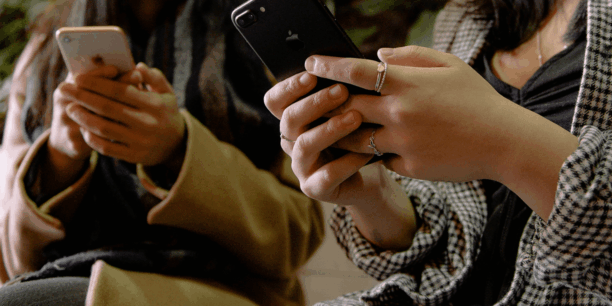How to Use Influencer Marketing to Expand Your Reach

Would you be more likely to give to a nonprofit if George Clooney asked you to, or if your favorite yogi with 3 million followers did? While nonprofits may think a Hollywood celebrity would give them the influence they need to rally support, Classy’s report Why America Gives found that more relatable champions of your cause—like social media influencers—were actually the most influential (9% vs. 26% for Hollywood celebrities and social media influencers, respectively).
With 78% of nonprofits already reporting social media as their top marketing channel, partnering with social media influencers is a natural evolution to increase awareness and expand the reach of your message. In this post, we’ll break down how to identify influencers and share six examples of how nonprofits can leverage their unique reach and relationship with their followers.
Who Are Influencers?
Think of influencer marketing as word-of-mouth marketing, but with a larger audience.
Your supporters hopefully already tell their friends, family, and coworkers about your cause. That type of trusted recommendation may have even resulted in that supporter’s connections making a donation to your nonprofit. In fact, almost half of consumer survey respondents (46%) said they are prompted to give unexpectedly if a family member or friend asks them to do so, and 50% said they would routinely give to a cause if a friend or family member were affected by that cause.
To tap into the power of personal connections on a larger scale, your nonprofit can partner with an influencer (an individual who has grown a large, engaged following on a blog or social media platform). That individual uses their platform to share your message with their digital audience.
You’ve likely seen influencer marketing in action when accounts you follow promote clothing from particular brands, tag restaurants in their food posts, or talk about products they love and use the hashtag #ad to indicate that they are in a paid partnership with a business. The nonprofit sector can adopt this strategy by having influencers share your campaigns or content around your mission.
Where Do I Find Influencers?
You can think of influencers as existing within two buckets:
Micro-Influencers
Micro-influencers are individuals and community partners who are already in your network and support your work. They may be volunteers, board members, event attendees, or donors. To identify micro-influencers with whom it may be beneficial to form a more official influencer partnership, scan your current networks by:
- Looking through your email list
- Browsing your followers on social media
- Reviewing volunteer and event logs
- Examining your board members
Look for people within these groups who have 1,000 or more followers on social media, actively engage with their platforms, and have a history of interacting with your content. Pick a few to connect with one-on-one to discuss how you can support them in sharing your nonprofit’s work using their micro-influencer status.
Macro-Influencers
Macro-influencers are people with social media accounts who have amassed large followings, typically in the tens of thousands and above. These influencers likely already partner with for-profit brands to promote their products, but may also be open to using their platform to shed light on causes they care about.
To find potential macro-influencers to partner with, you’ll need to do some googling and hashtag research.
Depending on your nonprofit’s mission, you can search for blogs and influencers within a specific niche. For example, if your nonprofit focuses on early childhood literacy, you can search for popular parenting bloggers or children’s book authors. Once you identify them, check out their social media pages to see what their following is like, how they promote their work, and whether their content, voice, and tone feel in line with your nonprofit’s values.
You can also perform research directly in different social media platforms by searching for posts with specific hashtags. Look for influencers who may be using generic social good hashtags, such as:
- #socialimpact
- #socialgood
- #philanthropy
- #4charity
- #communityservice
- #givingback
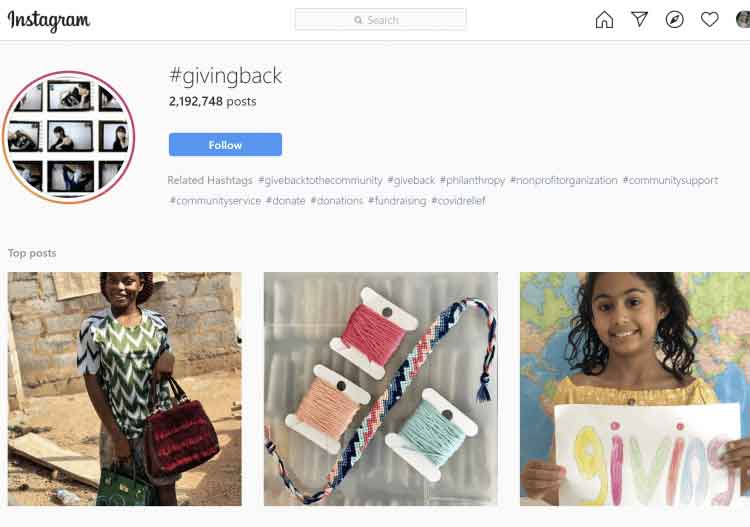
From the posts that pop up in your search, look for those with high numbers of comments and likes to identify accounts with not just large followings, but engaged users.
You can also search for hashtags related to your cause to find individuals already interested in your topic. For example, searching Instagram for the hashtag #literacy might lead you to popular posts by @reusablefamily. This account has 13,000 followers and describes its platform as: “Raising two strong girls through sustainable toys, an emphasis on reading, and learning through play.”
Judging by their bio, the owner of this account might be interested in supporting your nonprofit’s mission to improve early childhood literacy.
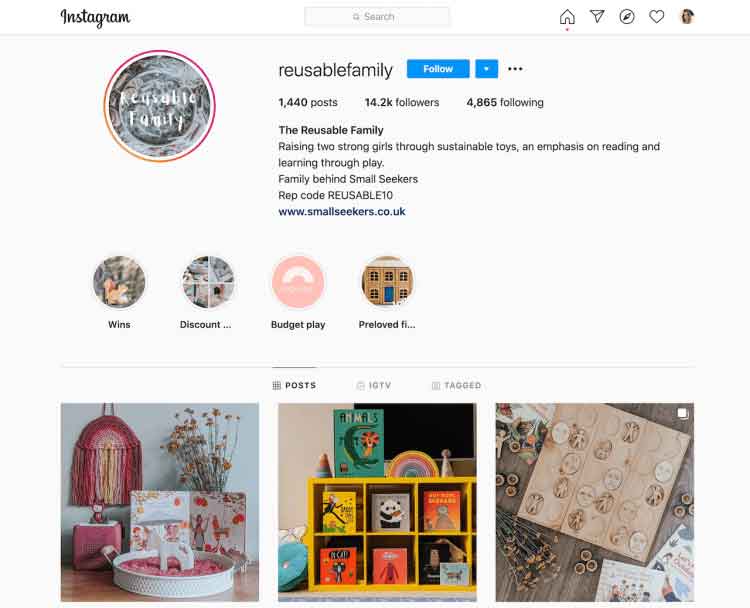
6 Ways to Partner With Your Influencers
Once you have identified your influencers, you can partner with them to help your nonprofit stand out on social media, spread awareness about your mission, and, ultimately, earn donations.
To get started, make sure you are aligned in your expectations of the partnership. Start out by asking how your cause resonates with them. Are there specific programs they connect with or initiatives they’d like to support? This will help inform your team on how to make this a meaningful experience that your influencer partner will be happy to continue to put their own time into.
Next, ask them how involved they are willing to be. You can ask how many posts they’d like to share per month, the type of engagements they are open to, and if there’s anything they will not do. This will strengthen your partnership and help your team provide them with the right materials to be successful.
Regardless of the nature of your partnership, share information about your mission and your nonprofit’s work. Since your messaging is likely different from their usual content, share nonprofit storytelling best practices with them. Share tips on how to leverage powerful statistics, your key messaging, branded language, photos, and examples of your most popular social media posts that resonated with supporters.
Once you have a shared agreement on the nature of your partnership, it’s time to get creative and identify the tactics you want to use. Here are six examples of how nonprofits have successfully used influencer marketing to help get your own strategy started.
1. Give Back Profits
Creative entrepreneurs can both share your message on their social media channels, as well as encourage their followers to give to your nonprofit by sharing profits from their sales. This style of influencer marketing both spreads your mission and generates revenue.
For example, during the holiday season, photographer Shannon Kalahan told her followers that 10% of the profits from sales of her prints would go to Heifer International. In that call to action, she also shared why Heifer International is one of her favorite nonprofits.
2. Coordinate Exclusive Products
Another way to partner with an influencer is through coordinating the sale of gift boxes or products that will benefit your nonprofit. These exclusive products often include the nonprofit’s logo or other branding, raising awareness of your brand whenever they’re worn or used by purchasers.
In these instances of influencer marketing, the influencers often leverage their connections with other businesses to create exclusive products.
For example, popular lifestyle blogger Vanessa Scott teamed up with Saks OFF 5TH to produce and market an exclusive shirt to benefit Girls Inc. The shirt uses the same colors as the Girls Inc. brand. In her Instagram post announcing the product, Vanessa shares why Girls Inc. is an important nonprofit to her and mentions that 100% of proceeds from the shirt sales will be donated.
3. Describe a Personal Story About Your Mission
Part of the reason people connect and form relationships with social media influencers is because they are good storytellers. Their personal connection to your mission can help share the emotional drive needed to encourage people to understand and support your cause.
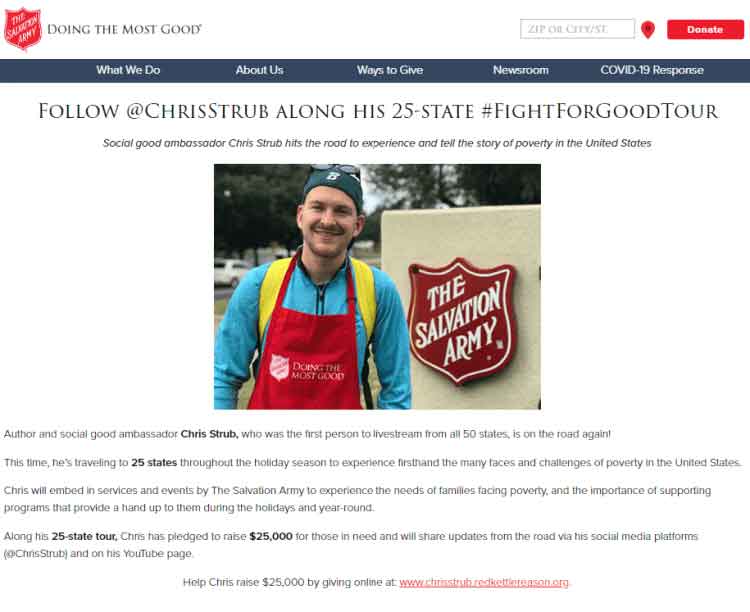
For example, author and social good ambassador Chris Strub partnered with The Salvation Army as part of a #FightForGoodTour. On this tour, he traveled through 25 different states to learn about and tell the story of The Salvation Army. He spoke with people experiencing poverty and The Salvation Army staff running the programs that provide support to them. Along the way, he used his social media platforms to link to his Classy fundraising page to raise $25,000 for the nonprofit. This is also an example with how you can get creative with how you can fit into an influencer’s existing way of engaging their audience, or reimagining a new activity entirely.
4. Livestream an Event
When situations allow for them, influencers can livestream in-person events, helping share your message with an audience beyond those who can attend. For example, they can share videos of keynote speakers, photos of event activities, and updates on progress toward fundraising goals in their Instagram stories. While sharing highlights from the event and why they support your nonprofit, they can weave in a call to action for their followers to donate to your nonprofit through a provided link.
Even if you’re unable to host an in-person event, influencers can provide social media updates about your virtual events, encourage their followers to attend, share the link to donate, and even raise money and attend the event themselves. Sheroes Hangout partnered with British model and beauty pageant winner Emma Jenkins to participate in their live Zoom event, which brought over 900 people to the call and raised over £10,000 in 40 minutes. After the live event, she followed up with a summary post, encouraging her followers to keep giving.
Another creative way to tap into the excitement of live events comes from the gaming platform Twitch. Twitch is a live streaming service for gamers where followers can watch and chat with their favorite gamers as they play. Twitch user @DrDisrepect has 4.4 million followers and for the entire month of June is using the platform to raise money for the Center for Policing Equity and the Equal Justice Initiative.
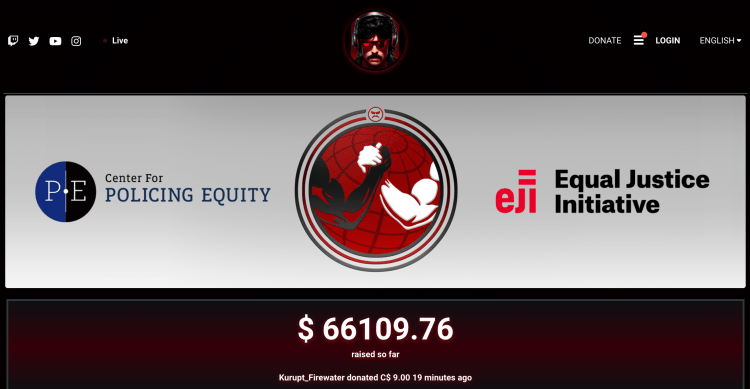
Pro Tip: You can now embed a live steam video on your Classy campaign page. Leverage this during a live event to make it easy for virtual attendees to make a donation and watch your event, or upload a static video to drum up excitement before a live event. If you plan to use live video, we recommend doing a run-through with a live stream video before the event.
5. Host a Virtual Meet and Greet
With many fundraising efforts needing to stay in the virtual space right now, influencers can use their platforms to create Instagram and Snapchat stories that introduce themselves, your nonprofit, and your current fundraising initiatives. These virtual meet and greets humanize your nonprofit and give influencers’ followers a chance to ask questions to someone they trust.
Every year, Shriners Hospitals for Children selects two National Patient Ambassadors to represent their patients. Those ambassadors spend a year sharing stories of how Shriners made a difference in their lives and describing their stories of perseverance. This year’s ambassadors, Christian and Madelyn, have done Instagram takeovers for Shriners to share their stories and link to fundraising pages.
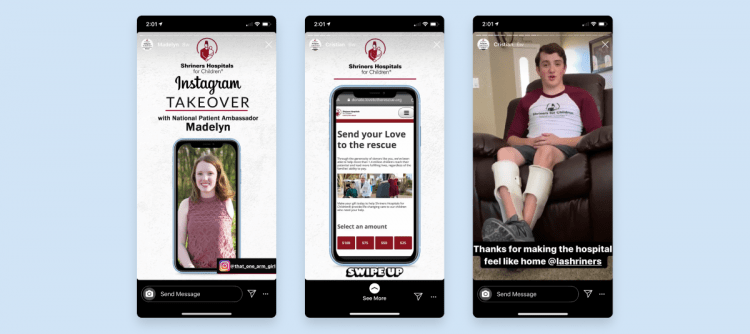
These virtual meet and greet Instagram takeovers create perfect material for your influencers to then share and highlight on their platforms. Christian and Madelyn bring Shriners’ mission to life, and influencers ensure that more people get their eyes on those stories. Your influencers can encourage their audience to ask questions about your organization, follow your page, and make a donation.
6. Share a Campaign
If you did your research and found an influencer who is aligned with your mission, it’s likely that their followers share some of the same interests. This may seem obvious, but it’s a great idea to point this out to your influencer partner to remind them that their personal touch is what will make the audience receptive to your nonprofit’s content.
So even with a tactic as straightforward as sharing your fundraising campaign, it’s crucial your influencer partner includes a personal message along with it. This is what differentiates this type of post from a targeted ad that might pop up on someone’s feed.
For example, Gemma Sisson has built a social media following around her diagnosis and journey with terminal cancer. Her community is receptive to the struggles associated with her cause and likely know others personally affected by these diagnoses. She has used her platform to share fundraising campaigns for Sue Ryder, a nonprofit providing palliative, neurological, and bereavement support. In the example post below, she shares why the nonprofit is important to her and includes a link to where followers can donate.
Leverage Influencer Marketing to Make an Impact
Influencer marketing goes beyond someone with a large following asking for donations. It taps into personal experiences that make the meaning of a donation come alive. Further, it’s an influencer’s job to know their audience, including the type of content they like, what time to post, and the medium they prefer. All of this works in your favor and will make their community more open to seeing your nonprofit’s mission in their feed.
Influencer marketing allows your nonprofit to reach a wider audience through trustworthy, authentic voices. By identifying and supporting potential influencers, your nonprofit can elevate its message throughout various social media platforms.

The Big Guide to Social Media for Nonprofits


